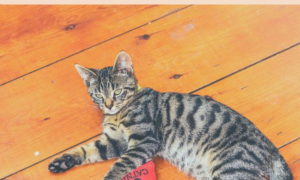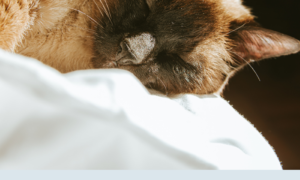By Jennifer Viegas for The Daily Cat

Bubba the cat is old and surprisingly big. At the age of 20, years of health issues and related inactivity had turned him into one fat cat. While most felines his age are receiver thin, Bubba looked more like a linebacker. At 24, he developed a problem that troubled both him and his owner — Bubba would get stuck in the entrance hole to his hooded litter box.
The solution, at first, seemed obvious. Remove the hood to allow easier access. But Bubba, as it turns out, had other problems. Arthritis made it difficult for him to step in and out of the box. Finding the whole ordeal too much trouble, he simply went on the nearby floor, or anywhere.
Fortunately for Bubba, he was a client of Colleen Paige, an author and Washington state-based animal behaviorist. Paige, who also has a background in interior design, resolved the problem by cutting a wide opening into a wicker basket, which served as a makeshift hood while still reminding Bubba of his old toilet setup. She chose a shallower pan and also had the owner put another litter box in the house, “since elderly cats become especially sensitive to litter soils and smells, and they also need quick and easy bathroom access.”
For challenges posed by older cats (11 years and above), you don’t have to locate someone in your town with credentials similar to Paige’s. Here are her suggestions for a “remodeling” project that you can do yourself.
Family Room
According to Paige, one of the biggest family room challenges faced by older cats has to do with getting on and off furniture, like sofas, tables and chairs. “Cats may be able to jump on, but jumping off can aggravate arthritis or, if an older feline misses its mark and slips, it may even dislocate or crack a bone,” she said. Paige advises placing large, “but not too fluffy,” and therefore unstable, pillows next to favorite feline furniture to cushion jumps.
Bedroom
If your cat enjoys lounging on your bed, or resting at the foot of your bed at night, it may experience similar difficulties jumping on and off your covers. Pillows, even stacked, likely will not help much, due to the height of most beds. Instead, Paige suggests purchasing carpeted stairs meant for dogs and cats. However, she quickly adds that some cats fear or avoid such stairs. “If that happens, you must teach your pet to use them and to not be afraid,” she said. “Place treats on each step, or perhaps lure your cat with catnip.”
Kitchen
Kitchen countertops seem to forever fascinate felines. Or perhaps you feed one or more cats on a kitchen counter. Paige said that is common in houses shared by both cats and dogs. “Cats may attack dogs, or vice versa, and cats might even squabble with other felines in your family,” she said, explaining the elevated dining arrangement.
But as a cat ages, jumping on and off counters can be extremely dangerous, given the hard surfaces usually found on both the counter and floor. Still, Paige understands the need to give cats a separate, quiet space to eat. She said, “To cats, a bowl of food represents survival, so their health and entire mindset can be affected when feeding problems arise.” If you are a counter cat feeder, she suggests letting your older cat(s) eat in the bathroom with the door closed. Then set a kitchen timer for a short, yet reasonable, amount of eating time “so you don’t forget they’re in the bathroom.”
For stubborn cats that either will not give up their countertop privileges, or continue to investigate your counters, Paige said taping balloons near popular jumping spots usually does the trick. Keep the balloons in place for a week or so, if possible, to de-condition your cat. Persistent felines without serious health problems may require that you pop one of the balloons just as your cat is about to jump. “Believe me,” Paige said. “It will probably be a long time before that cat considers jumping on the counters again.”
Furthermore. . .
Although your cat may need a literal leg up as it ages, Paige believes that maintaining a feline’s sense of self-control is paramount. “Remember that cats aren’t like dogs or needy people,” she said. “A dog may whimper, as if to say, ‘Please help me,’ but cats are more independent and like to at least think they can solve their own problems.”
Jennifer Viegas is the managing editor of The Daily Cat. She is a journalist for Discovery News, the news service for the Discovery Channel, and has written more than 20 books on animals, health and other science-related topics.





